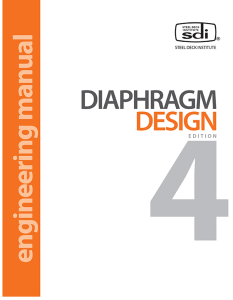The Steel Deck Institute (SDI) has released the new and long awaited 4th Edition of the Diaphragm Design Manual (DDM04). This new edition complies with the requirements of the new ANSI/AISI S310-13 North American Standard for the Design of Profiled Steel Diaphragm Panels. At 408 pages, the 4th Edition is larger than its predecessor and will be an invaluable resource to structural designers.
The First Edition of the DDM, published in 1980, was authored by Dr. Larry Luttrell, P.E., the Technical Advisor to the SDI. The diaphragm design method developed by Dr. Luttrell was based on a rational analytical model of the deck panels and the support and sidelap fasteners, which was substantiated by extensive testing. The Second Edition of the DDM, published in 1995, added a design method and design tables for floor deck diaphragms. A Third Edition was published in 2004. The new Fourth Edition is also authored by Dr. Luttrell, with the assistance of John Mattingly, P.E., SDI Technical Consultant; Walter Schultz, P.E., SDI Diaphragm Committee Chair, and Dr. Thomas Sputo, P.E., S.E., SDI Technical Director.
This new Fourth Edition improves the earlier 3rd Edition in several ways.
1) The Manual complies with the analysis and design methods contained within the AISI S310 Standard. The AISI S310 Standard puts the design method of the first three editions of the Diaphragm Design Manual into a building code enforceable standard. The resistance and safety factors are the same as those in the Third Edition (DDM03).
2) The Manual contains 26 design examples illustrating the design and analysis of steel deck diaphragms, both roof and floor deck. This is an increase over the previous edition which contained 16 examples.
3) New examples include calculation of deflections of non-symmetric diaphragms, diaphragms with open areas, and perforated and acoustical deck. Additional examples also show the calculation of diaphragm strength and stiffness using the AISI S310 provisions.
4) Examples include expanded discussion of the interaction of wind uplift with diaphragm strength.
5) Fasteners included in the Manual include generic welds and mechanical fasteners in accordance with the strength and flexibility provisions of AISI S310, but also include fastener strengths calculated in accordance with the previous DDM provisions, and proprietary screws and power actuated fasteners. The use of the previous DDM provisions and proprietary fasteners are permitted by AISI S310 as alternate fasteners with performance substantiated by testing.
6) Diaphragm load tables are separated into two sections; calculated using the generic AISI S310 weld and screw provisions, and calculated using the previous edition DDM fastener equations and proprietary fasteners. The same resistance and safety factors apply to both methods.
7) The diaphragm buckling strength limit has been updated based on further testing and analysis by the AISI Diaphragm Subcommittee.
8) Since the Second Edition, the strength of concrete filled steel deck diaphragms has been the sum of the strength of the deck, controlled by the fasteners and the concrete fill. AISI S310 and DDM04 place an upper limit on the contribution of the fasteners to 25% of the total diaphragm strength.
For more information on the 4th Edition Diaphragm Design Manual, visit the SDI website at www.sdi.org.▪

